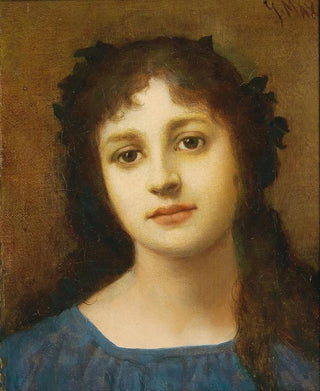Art print | Girl with Vines in Hair - Gabriel von Max


View from behind

Frame (optional)
In the fascinating universe of art, some works stand out for their ability to capture the very essence of beauty and nature. "Fille avec des feuilles de vigne dans les cheveux" by Gabriel von Max is undoubtedly one of these remarkable pieces. This artwork, which evokes a delicate harmony between humanity and the plant world, invites the viewer to immerse themselves in a dream where woman and nature blend seamlessly. The vine leaves, symbols of fertility and rebirth, intertwine with the young girl's hair, creating an image that is both sensual and poetic. The depiction of this female figure, at once wild and gentle, transports us to a universe of serenity and wonder.
Style and uniqueness of the work
Gabriel von Max's style is distinguished by his ability to combine realism and symbolism. In this piece, every detail is carefully crafted, from the delicate features of the face to the vine leaves surrounding the protagonist's hair. Light plays a crucial role, subtly illuminating the contours of the face and leaves, thus creating an atmosphere that is both intimate and mystical. The colors, soft and natural, evoke a palette inspired by nature itself, reinforcing the idea of a deep connection between man and his environment. This artwork does not merely depict a young girl; it tells a story, that of a communion between the human being and the world around them, inviting the viewer to feel this almost sacred union.
The artist and his influence
Gabriel von Max, a German-born artist, is often recognized for his unique approach to painting, blending elements of the Romantic school with Symbolist themes. His work is marked by a particular sensitivity towards nature and the human being, which allowed him to stand out in the artistic landscape of his time. Influenced by various currents, he draws inspiration from mythology, folklore, and human psychology, which is reflected in works like "Fille avec des feuilles de vigne dans les cheveux". His work has not only enriched 19th-century art but continues to inspire.

Matte finish

View from behind

Frame (optional)
In the fascinating universe of art, some works stand out for their ability to capture the very essence of beauty and nature. "Fille avec des feuilles de vigne dans les cheveux" by Gabriel von Max is undoubtedly one of these remarkable pieces. This artwork, which evokes a delicate harmony between humanity and the plant world, invites the viewer to immerse themselves in a dream where woman and nature blend seamlessly. The vine leaves, symbols of fertility and rebirth, intertwine with the young girl's hair, creating an image that is both sensual and poetic. The depiction of this female figure, at once wild and gentle, transports us to a universe of serenity and wonder.
Style and uniqueness of the work
Gabriel von Max's style is distinguished by his ability to combine realism and symbolism. In this piece, every detail is carefully crafted, from the delicate features of the face to the vine leaves surrounding the protagonist's hair. Light plays a crucial role, subtly illuminating the contours of the face and leaves, thus creating an atmosphere that is both intimate and mystical. The colors, soft and natural, evoke a palette inspired by nature itself, reinforcing the idea of a deep connection between man and his environment. This artwork does not merely depict a young girl; it tells a story, that of a communion between the human being and the world around them, inviting the viewer to feel this almost sacred union.
The artist and his influence
Gabriel von Max, a German-born artist, is often recognized for his unique approach to painting, blending elements of the Romantic school with Symbolist themes. His work is marked by a particular sensitivity towards nature and the human being, which allowed him to stand out in the artistic landscape of his time. Influenced by various currents, he draws inspiration from mythology, folklore, and human psychology, which is reflected in works like "Fille avec des feuilles de vigne dans les cheveux". His work has not only enriched 19th-century art but continues to inspire.






